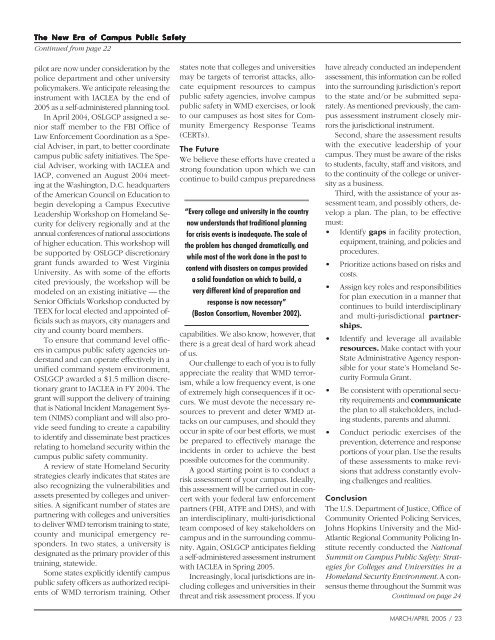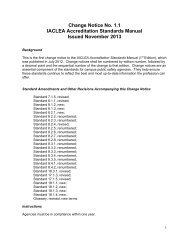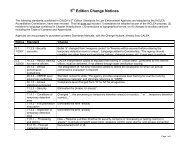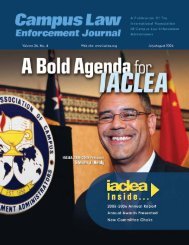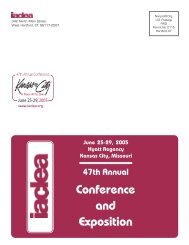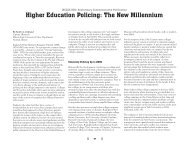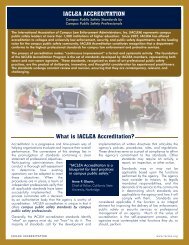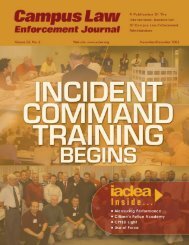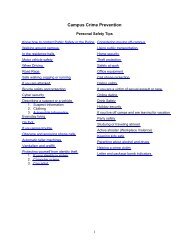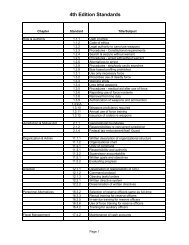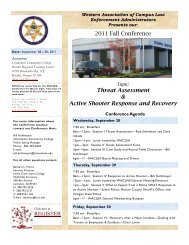Volume 35, No. 2 - March/April 2005 Campus Law ... - IACLEA
Volume 35, No. 2 - March/April 2005 Campus Law ... - IACLEA
Volume 35, No. 2 - March/April 2005 Campus Law ... - IACLEA
Create successful ePaper yourself
Turn your PDF publications into a flip-book with our unique Google optimized e-Paper software.
The New Era of <strong>Campus</strong> Public Safety<br />
Continued from page 22<br />
pilot are now under consideration by the<br />
police department and other university<br />
policymakers. We anticipate releasing the<br />
instrument with <strong>IACLEA</strong> by the end of<br />
<strong>2005</strong> as a self-administered planning tool.<br />
In <strong>April</strong> 2004, OSLGCP assigned a senior<br />
staff member to the FBI Office of<br />
<strong>Law</strong> Enforcement Coordination as a Special<br />
Adviser, in part, to better coordinate<br />
campus public safety initiatives. The Special<br />
Adviser, working with <strong>IACLEA</strong> and<br />
IACP, convened an August 2004 meeting<br />
at the Washington, D.C. headquarters<br />
of the American Council on Education to<br />
begin developing a <strong>Campus</strong> Executive<br />
Leadership Workshop on Homeland Security<br />
for delivery regionally and at the<br />
annual conferences of national associations<br />
of higher education. This workshop will<br />
be supported by OSLGCP discretionary<br />
grant funds awarded to West Virginia<br />
University. As with some of the efforts<br />
cited previously, the workshop will be<br />
modeled on an existing initiative — the<br />
Senior Officials Workshop conducted by<br />
TEEX for local elected and appointed officials<br />
such as mayors, city managers and<br />
city and county board members.<br />
To ensure that command level officers<br />
in campus public safety agencies understand<br />
and can operate effectively in a<br />
unified command system environment,<br />
OSLGCP awarded a $1.5 million discretionary<br />
grant to <strong>IACLEA</strong> in FY 2004. The<br />
grant will support the delivery of training<br />
that is National Incident Management System<br />
(NIMS) compliant and will also provide<br />
seed funding to create a capability<br />
to identify and disseminate best practices<br />
relating to homeland security within the<br />
campus public safety community.<br />
A review of state Homeland Security<br />
strategies clearly indicates that states are<br />
also recognizing the vulnerabilities and<br />
assets presented by colleges and universities.<br />
A significant number of states are<br />
partnering with colleges and universities<br />
to deliver WMD terrorism training to state,<br />
county and municipal emergency responders.<br />
In two states, a university is<br />
designated as the primary provider of this<br />
training, statewide.<br />
Some states explicitly identify campus<br />
public safety officers as authorized recipients<br />
of WMD terrorism training. Other<br />
states note that colleges and universities<br />
may be targets of terrorist attacks, allocate<br />
equipment resources to campus<br />
public safety agencies, involve campus<br />
public safety in WMD exercises, or look<br />
to our campuses as host sites for Community<br />
Emergency Response Teams<br />
(CERTs).<br />
The Future<br />
We believe these efforts have created a<br />
strong foundation upon which we can<br />
continue to build campus preparedness<br />
“Every college and university in the country<br />
now understands that traditional planning<br />
for crisis events is inadequate. The scale of<br />
the problem has changed dramatically, and<br />
while most of the work done in the past to<br />
contend with disasters on campus provided<br />
a solid foundation on which to build, a<br />
very different kind of preparation and<br />
response is now necessary”<br />
(Boston Consortium, <strong>No</strong>vember 2002).<br />
capabilities. We also know, however, that<br />
there is a great deal of hard work ahead<br />
of us.<br />
Our challenge to each of you is to fully<br />
appreciate the reality that WMD terrorism,<br />
while a low frequency event, is one<br />
of extremely high consequences if it occurs.<br />
We must devote the necessary resources<br />
to prevent and deter WMD attacks<br />
on our campuses, and should they<br />
occur in spite of our best efforts, we must<br />
be prepared to effectively manage the<br />
incidents in order to achieve the best<br />
possible outcomes for the community.<br />
A good starting point is to conduct a<br />
risk assessment of your campus. Ideally,<br />
this assessment will be carried out in concert<br />
with your federal law enforcement<br />
partners (FBI, ATFE and DHS), and with<br />
an interdisciplinary, multi-jurisdictional<br />
team composed of key stakeholders on<br />
campus and in the surrounding community.<br />
Again, OSLGCP anticipates fielding<br />
a self-administered assessment instrument<br />
with <strong>IACLEA</strong> in Spring <strong>2005</strong>.<br />
Increasingly, local jurisdictions are including<br />
colleges and universities in their<br />
threat and risk assessment process. If you<br />
have already conducted an independent<br />
assessment, this information can be rolled<br />
into the surrounding jurisdiction’s report<br />
to the state and/or be submitted separately.<br />
As mentioned previously, the campus<br />
assessment instrument closely mirrors<br />
the jurisdictional instrument.<br />
Second, share the assessment results<br />
with the executive leadership of your<br />
campus. They must be aware of the risks<br />
to students, faculty, staff and visitors, and<br />
to the continuity of the college or university<br />
as a business.<br />
Third, with the assistance of your assessment<br />
team, and possibly others, develop<br />
a plan. The plan, to be effective<br />
must:<br />
• Identify gaps in facility protection,<br />
equipment, training, and policies and<br />
procedures.<br />
• Prioritize actions based on risks and<br />
costs.<br />
• Assign key roles and responsibilities<br />
for plan execution in a manner that<br />
continues to build interdisciplinary<br />
and multi-jurisdictional partnerships.<br />
• Identify and leverage all available<br />
resources. Make contact with your<br />
State Administrative Agency responsible<br />
for your state’s Homeland Security<br />
Formula Grant.<br />
• Be consistent with operational security<br />
requirements and communicate<br />
the plan to all stakeholders, including<br />
students, parents and alumni.<br />
• Conduct periodic exercises of the<br />
prevention, deterrence and response<br />
portions of your plan. Use the results<br />
of these assessments to make revisions<br />
that address constantly evolving<br />
challenges and realities.<br />
Conclusion<br />
The U.S. Department of Justice, Office of<br />
Community Oriented Policing Services,<br />
Johns Hopkins University and the Mid-<br />
Atlantic Regional Community Policing Institute<br />
recently conducted the National<br />
Summit on <strong>Campus</strong> Public Safety: Strategies<br />
for Colleges and Universities in a<br />
Homeland Security Environment. A consensus<br />
theme throughout the Summit was<br />
Continued on page 24<br />
MARCH/APRIL <strong>2005</strong> / 23


